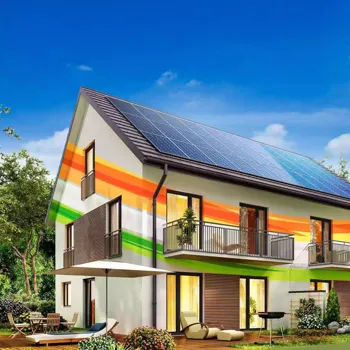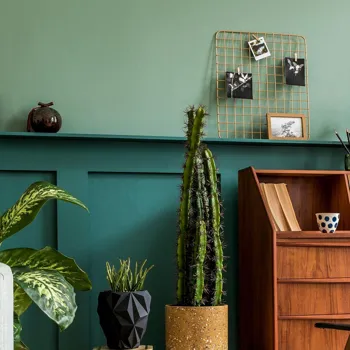Discover 10 Easy Ways to Make Your Home More Eco-Friendly and reduce your carbon footprint while saving money. Read on!
Namaste, readers! Are you feeling the garmi a bit more intensely these days? Well,
you're not alone! Climate change is real, and it's upon us. But don't you worry, even small changes in our daily habits can make a big difference.
Let's explore ten simple ways to make your home more eco-friendly, reduce your carbon footprint, and save some money in the process! Think of it as doing your bit for Mother Earth, one step at a time. These steps are not only good for the environment but also good for your pocket!
Our homes are where we spend a significant portion of our lives, and they contribute a lot to our overall environmental impact. Simply put, our homes consume energy, water, and generate waste. But with a few conscious decisions and tweaks, we can turn our homes into eco-friendly havens.
Consider these ten points, and see how easily you can change the situation. Imagine a world where every household contributes towards a greener future.
Switch to energy-efficient lighting:
One of the easiest and most impactful changes you can make is switching from traditional incandescent bulbs to LED lights. LEDs consume up to 75% less energy and last much longer, saving you money on your electricity bill and reducing your carbon footprint. It's a win-win!

Plus, they come in a variety of colors and brightness levels so you can find the perfect fit for every room in your home. So next time you are out shopping, check the energy efficiency rating of the lights.
LEDs are not just energy-efficient; they are also more durable and have a longer lifespan compared to traditional bulbs. This means you won't have to replace them as often, saving you time and money in the long run.
Moreover, LEDs don't contain harmful substances like mercury, making them a safer and more environmentally friendly choice. By switching to LEDs, you're not only reducing your energy consumption but also contributing to a healthier planet.
So, make the switch today and brighten up your home while lightening your footprint.
Embrace natural light and ventilation:
Make the most of natural light by opening your curtains and blinds during the day. Natural light is not only free but also improves your mood and reduces your reliance on artificial lighting. Also, cross-ventilation helps cool your home naturally, reducing the need for air conditioning.

Open windows and doors on opposite sides of your home to create a refreshing breeze. It's a natural way to manage temperature!
Another way to maximize natural light is by strategically placing mirrors in your home.
Mirrors can reflect and amplify natural light, making your space appear brighter and more spacious. Similarly, consider using light-colored paint on your walls to reflect more light and reduce the need for artificial lighting.
By embracing natural light and ventilation, you're not only creating a more comfortable and inviting home but also reducing your energy consumption and contributing to a healthier environment. So, open those windows and let the sunshine in!
Conserve water:
Water is a precious resource, and it's important to use it wisely. Install low-flow showerheads and faucets to reduce water consumption without compromising water pressure. Fix any leaks promptly, no matter how small, as they can waste significant amounts of water over time.
When washing clothes or dishes, always use full loads to maximize efficiency. Do not leave the tap running while brushing your teeth!
In addition to these tips, consider collecting rainwater to water your plants or wash your car.
Rainwater is a natural and sustainable source of water that can help you reduce your reliance on municipal water supplies. You can also install a greywater system to reuse water from your shower or washing machine for flushing toilets or watering your garden.
By conserving water in your home, you're not only saving money on your water bill but also helping to protect this valuable resource for future generations. So, let's be mindful of our water usage and make every drop count!
Reduce, Reuse, Recycle:
This is a classic mantra for a reason! Reduce your consumption by buying less stuff and choosing products with minimal packaging. Reuse items whenever possible – glass jars can become storage containers, old t-shirts can be turned into cleaning rags, and so on.

Recycle diligently, and familiarize yourself with your local recycling guidelines. Proper waste segregation is key! When shopping always prefer getting cloth bag instead of plastic ones.
Consider buying products that are made from recycled materials.
Not only are you supporting the recycling industry, but you are also reducing the demand for virgin materials. When you have items that you no longer need, consider donating them to charity or selling them online.
This not only prevents these items from ending up in landfills but also gives them a new lease on life. Remember, reducing, reusing, and recycling are essential steps towards a more sustainable lifestyle.
Compost your food waste:
Food waste is a major problem, contributing to greenhouse gas emissions in landfills. Start a compost bin in your backyard or use a kitchen composter to turn food scraps into nutrient-rich soil for your garden.
Composting reduces waste, improves soil health, and reduces the need for chemical fertilizers. You can compost vegetable peels, fruit rinds, coffee grounds, and other organic matter.
If you don’t have a garden, you can donate your compost to community gardens or offer it to friends and neighbors who have gardens. Composting is a simple yet effective way to reduce your environmental impact and create a more sustainable lifestyle.
So, start composting today and turn your food waste into something valuable! It's an amazing addition on this list of easy steps.
Go Green with Cleaning Products:
Many conventional cleaning products contain harmful chemicals that can pollute the air and water. Switch to natural and eco-friendly cleaning products made from plant-based ingredients. You can also make your own cleaning solutions using simple ingredients like vinegar, baking soda, and lemon juice.

Not only are natural cleaning products better for the environment, but they are also safer for your family and pets. There are many recipes available online.
When choosing cleaning products, look for those that are biodegradable, phosphate-free, and fragrance-free.
You can also opt for concentrated cleaning products that require less packaging and reduce waste. Remember, a clean home doesn’t have to come at the expense of the environment or your health. So, make the switch to green cleaning products and create a healthier and more sustainable home.
Try it after you have read this article.
Unplug Electronics:
Even when turned off, many electronics continue to draw power, a phenomenon known as "phantom load." Unplug electronics when not in use, or use power strips to easily switch off multiple devices at once.
This simple habit can save you money on your electricity bill and reduce your energy consumption. It is one of the easiest ways to save.
Insulate Your Home:
Proper insulation can significantly reduce your energy consumption by keeping your home warmer in the winter and cooler in the summer. Insulate your walls, attic, and floors to minimize heat loss and gain.
This will help you save money on your heating and cooling bills and create a more comfortable living environment. A one time expense but worth your time.
In conclusion, making your home more eco-friendly is not only good for the environment but also good for your wallet and your well-being.
By adopting these ten simple changes, you can reduce your carbon footprint, conserve resources, and create a healthier and more sustainable home. Start small, be consistent, and encourage your family and friends to join you on your eco-friendly journey. Together, we can make a difference!
Support Local and Sustainable Businesses:
When shopping for groceries, household goods, or other products, choose local and sustainable businesses that prioritize environmental responsibility. Supporting local businesses reduces transportation emissions and helps strengthen your community.

Look for products that are ethically sourced, fairly traded, and sustainably produced.
Plant Trees and Grow Plants:
Planting trees and growing plants around your home can improve air quality, reduce the urban heat island effect, and create a more beautiful and inviting environment. Trees absorb carbon dioxide from the atmosphere and release oxygen, helping to combat climate change.
Gardening is also a great way to connect with nature, reduce stress, and grow your own food.
AI Generated Content. Glance/InMobi shall have no liability for the content








